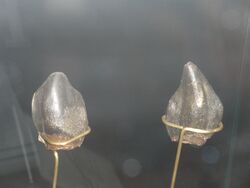Biology:Neosodon
| Neosodon | |
|---|---|

| |
| Neosodon teeth | |
| Scientific classification | |
| Domain: | Eukaryota |
| Kingdom: | Animalia |
| Phylum: | Chordata |
| Clade: | Dinosauria |
| Clade: | Saurischia |
| Clade: | †Sauropodomorpha |
| Clade: | †Sauropoda |
| Genus: | †Neosodon Moussaye, 1885 |
Neosodon (meaning "new tooth") was a genus of sauropod dinosaur from the Late Tithonian-age Upper Jurassic Sables et Gres a Trigonia gibbosa of Pas-de-Calais department, France .[1][2] It has never been formally given a species name, but is often seen as N. praecursor, which actually comes from a different animal. Often in the past, it had been assigned to the wastebasket taxon Pelorosaurus, but restudy has suggested that it could be related to Turiasaurus, a roughly contemporaneous giant Spain sauropod. It is only known from six teeth.[3]
History and taxonomy
Moussaye named this genus for a large, broken, worn tooth found in Wilmille, near Boulogne-sur-Mer, and neglected to give it a species name. He thought that it belonged to a theropod like Megalosaurus.[3] Since then, five more teeth have been found and assigned to Neosodon.
Sauvage synonymized it with his tooth species Iguanodon praecursor,[4][5] which by this time had become mixed up with Edward Drinker Cope's roughly contemporaneous United States Morrison Formation genus Caulodon (now a synonym of Camarasaurus). However, the two are not based on the same type, as "I". praecursor comes from slightly older rocks: the same unnamed Kimmeridgian formation as Morinosaurus.[6] Earlier reviews (Romer, 1956; Steel, 1970) accepted it as a synonym of Pelorosaurus, and considered it a possible brachiosaurid.[7][8]
In the 1990s, French researchers published on new camarasaurid bones from the same formation. At first, Buffetaut and Martin (1993) suggested that they belonged to Neosodon praecursor,[9] but Le Loeuff et al. (1996) later rejected this, as Neosodon is based only on several teeth, which did not overlap the new material.[10] The latest review accepted both Neosodon and "Iguanodon" praecursor as dubious sauropods.[11] However, Royo-Torres et al. (2006), in their description of Turiasaurus, noted that this tooth was similar to those of their genus and suggested that it could be a turiasaur.[12]
Paleobiology
The teeth referred to Neosodon are large (60 mm [2.36 in] tall and a cross-section of 35 by 20 mm (1.38 by 0.79 in) in its incomplete state, estimated at 80 mm [3.15 in] tall if complete)[3] and spear-like or spatulate in shape. The owner would have been a large, quadrupedal herbivore.[11]
References
- ↑ Weishampel, David B; et al. (2004). "Dinosaur distribution (Late Jurassic, Europe)." In: Weishampel, David B.; Dodson, Peter; and Osmólska, Halszka (eds.): The Dinosauria, 2nd, Berkeley: University of California Press. Pp. 545–549. ISBN:0-520-24209-2
- ↑ Dinosaurs of France
- ↑ 3.0 3.1 3.2 Moussaye, M. de la. (1885). Sur une dent de Neosodon, trouvée dans les sables ferruginaux de Wilmille. Bulletin, Société Géologique de France 3(13):51-53. [French]
- ↑ Sauvage, H.E. (1888). Sur les reptiles trouvés dans le Portlandian supérieur de Boulogne-sur-mer. Bulletin du Muséum National d'Historie Naturalle, Paris. 3(16):626. [French]
- ↑ *Paleobiology Database entry; see Taxonomic History for some idea of the confusion regarding "I." praecursor
- ↑ Weishampel, D.B., Barrett, P.M., Coria, R.A., Le Loeuff, J., Xu Xing, Zhao Xijin, Sahni, A., Gomani, E.M.P., and Noto, C.R. (2004). Dinosaur Distribution: in Weishampel, D.B., Dodson, P., and Osmólska, H., (eds.). The Dinosauria (2nd edition). University of California Press:Berkeley 517-606. ISBN:0-520-24209-2
- ↑ Romer, A.S. (1956). Osteology of the Reptiles. University of Chicago Press:Chicago 1-772. ISBN:0-89464-985-X
- ↑ Steel, R. (1970). Part 14. Saurischia. Handbuch der Paläoherpetologie/Encyclopedia of Paleoherpetology. Part 14. Gustav Fischer Verlag:Stuttgart p. 1-87.
- ↑ Buffetaut, E., and Martin, M. (1993). Late Jurassic dinosaurs from the Boulonnais (northern France): a review. Revue de Paléobiologie, Volume spéciale 7:17-28.
- ↑ Le Loeuff, J., Buffetaut, E., and Merser, C. (1996). Discovery of a Tithonian sauropod dinosaur in Charente (western France). Géologie de la France 2:79-81. [French]
- ↑ 11.0 11.1 Upchurch, P.M., Barrett, P.M., and Dodson, P. (2004). Sauropoda. In: Weishampel, D.B., Dodson, P., and Osmólska, H. (eds.). The Dinosauria (2nd edition). University of California Press:Berkeley 259-322. ISBN:0-520-24209-2
- ↑ Royo-Torres, R., Cobos, A., and Alcalá, L. (2006). A giant European dinosaur and a new sauropod clade. Science 314:1925-1927.
Wikidata ☰ Q2030683 entry
 |

